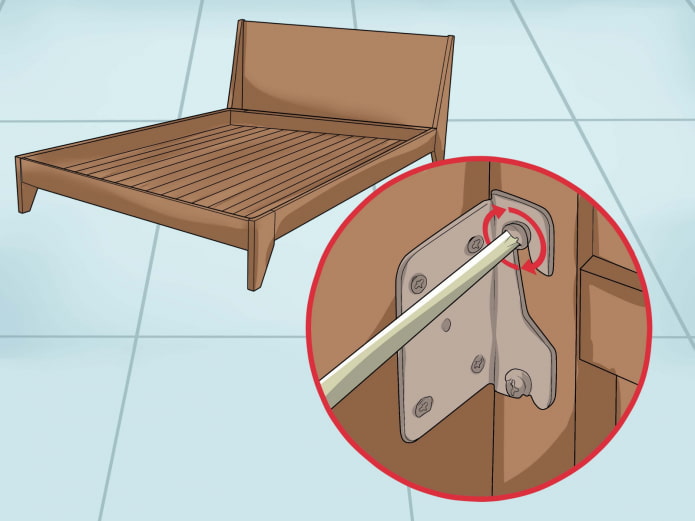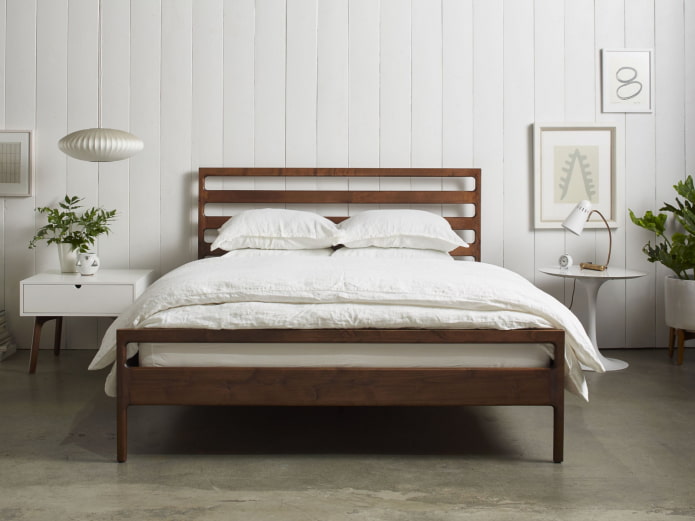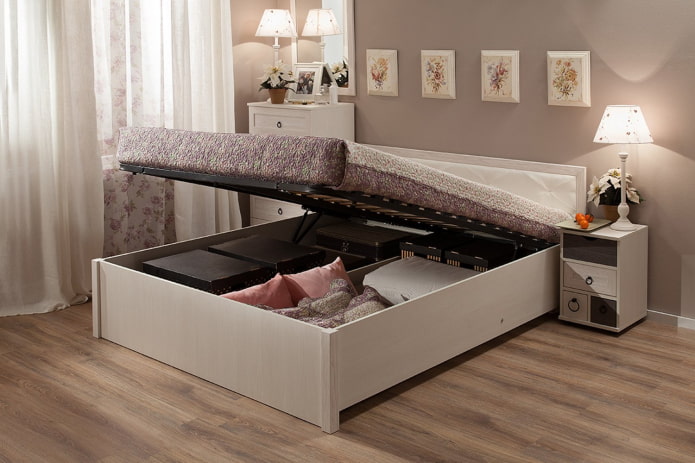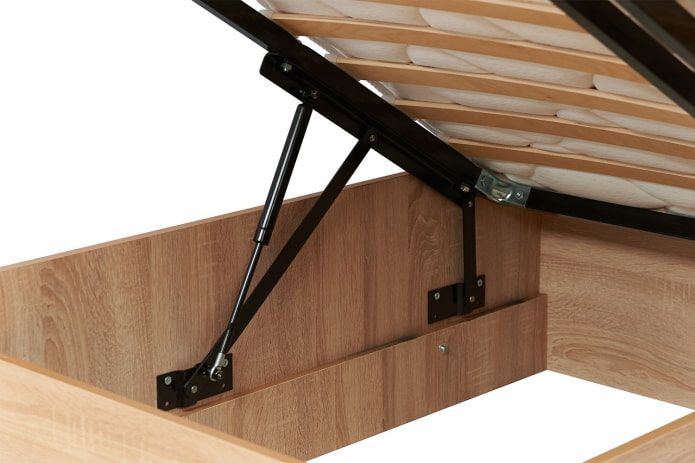The reasons for the squeak
To eliminate the creaks of the bed, you need to understand why they appeared at all. There may be several sources:
- Loose or broken fasteners. The bolts and nuts on which the bed frame is assembled tend to loosen - sometimes, to remove the grinding noise, it is enough to tighten them.
- Problems with the prosthetic base. It consists of several elements, each of which can be the cause: lamellas, lat holders, frame.
- Damage to the mattress springs. Most often this happens with models on a dependent spring block of poor quality - parts rub against each other and make an unpleasant sound.
- Friction at the joints. The attachment points of the legs to the sidewalls, the joints of the sidewalls and other docking areas can lead to the bed joint. The parts just rub against each other.
Finding the source of the squeak
As you understood from the previous section, the creak of the bed can come from any part of it. Your task is to separate these parts from each other as much as possible, find the problem area and work with it.
- First of all, remove the mattress, put it on the floor, walk on it. You must make sure that it is not the source of the noise.
- Next, we move on to the base of the bed. Support strips, fasteners, joints, lifting mechanism (if any) can emit creaks. Raise and lower the gas lift, listen to the sound. Press down on all the logs one by one, check their fasteners, wiggle each corner and leg.
- If nothing is cracking, go to the box. Rock the legs of the bed, corners and joints of the structure.
Elimination begins only after determining the most accurate source of the bed squeak.
We remove the creak of a wooden bed
The wooden bed in the interior starts to creak more often than others. However, it is usually easier to cope with the grinding of a wooden model: just tighten all the fasteners. For this:
- Remove the mattress, remove the base if possible.
- Tighten all corner bolts, leg holders, and other visible items using a ratchet, wrench, or whatever you can do.
- Check if the bed squeaks, if not, put it back.
Tip: It is advisable to process the fasteners - drop a drop of machine oil on each bolt or walk along the thread with paraffin. The nut will hold better and will not squeak.
Suitable grease options:
- Paraffin. There are candles in almost every home, so you don't have to spend money on special tools. Both metal and wood elements are rubbed with paraffin or wax - it perfectly removes noise.
- Silicone. It is sold in almost all hardware stores, it is inexpensive. Provides reliable protection against creaking.
- WD-40. To use this deep penetration lubricant, it is not even necessary to disassemble the structure into separate parts. The only negative is that the grease dries quickly, so you will have to repeat the procedure more often.
- Machine oil. An option when you need it cheap and cheerful. But do not use it on wooden parts, otherwise you risk getting stubborn greasy stains, which are almost impossible to get rid of.
A wooden bed won't rattle for no reason.Sounds come from prolonged use. But if the sleeping place is not yet six months old, check the floor level. The bed creak may be caused by an uneven base and may need to be moved.
A double bed made of wood with a heavy headboard can also be a source of sound. The headboard loosens, large gaps form and it starts to creak unpleasantly. Tightening the bolts is not sufficient in this case:
- Free the wooden bed from the mattress and base.
- Unscrew the headboard.
- Coat the joints with rubber glue.
- Insert spacers of felt, silicone, or other material into the gaps.
- Assemble the structure back, not forgetting about the silicone grease for the fasteners.
Preventing squeaking is always easier than getting rid of it:
- when buying, pay attention to the quality of wood or chipboard, there should be no waves, bulges or damage;
- give preference to a mattress on an independent spring block - it is protected from sounds. comfortable, durable;
- set the bed on a level place - check the covering with a level, all legs should be firmly on the floor;
- lean the high headboard on the wall, so it will have less opportunity to loosen;
- tighten the bolts every 3-6 months (if possible, reinforce them with washers), lubricate the elements.
Getting rid of the creak of a bed with a lifting mechanism
The more touching parts there are in the furniture, the more likely it is to hear creaking. Therefore, when purchasing a model with a rise, do not be surprised why the bed creaks. However, with proper care and attention, your sleeping place will last a long time without extraneous sounds.
If the bed is already creaking, listen and find the reason:
- lamellas or base boards;
- holders of armor;
- body;
- parts of the lifting mechanism.
To begin with, let's deal with the base itself: the creak of the bed causes friction at the junctions, damaged slats and their locks.
- Remove the mattress.
- Press and rock the base from different angles to locate the source.
- Check all the lamellas and their holders - they must be firmly held in the grooves.
- Wiggle your legs.
How to get rid of the creak of the bed if the lamella holder is broken? As with the breakage of the plate itself, only replacement will help - parts are sold in many furniture stores. The repair process depends on the type of your tip and its attachment, usually it is enough to unscrew a couple of screws and screw them back in.
The base creaks, but the lamellas and tips are intact? Disassemble them, lubricate the fasteners, add a thin spacer between the plate and the holder.
If the source publishes the lifting mechanism itself, it makes no sense to repair it - just change it.
- Remove the mattress, raise the base.
- Unscrew the gas lift from the base and frame.
- Purchase the same model from the store.
- Reinstall.
Eliminate the creak of a metal bed
Does the metal bed creak? There are two main reasons: fasteners are loose or parts rub against each other.
What to do to prevent the bed from creaking:
- Remove the mattress and base, making sure the frame itself is squeaking.
- Lubricate all bolts and joints.
- Tighten each nut well.
It happens that debris gets into the junction - due to one tiny grain of sand, the structure can begin to creak loudly. Try vacuuming the area or disassemble and wipe with a damp cloth to remove any debris.
Prevention of extraneous sounds:
- Tighten the screws periodically (once every 3-6 months); if defects appear, they must be replaced with new ones.
- Lubricate parts at the same intervals.
- The headboard is an area of increased stress. To prevent the appearance of noise here, it is enough to put a rubber or silicone gasket in the corners.
- Do a damp mop whenever you change your bedding.
A creaky bed requires repair, not replacement. Getting rid of the noise is easy - take a little time to find the cause and fix it.


 10 practical tips for arranging a small kitchen in the country
10 practical tips for arranging a small kitchen in the country
 12 simple ideas for a small garden that will make it visually spacious
12 simple ideas for a small garden that will make it visually spacious







 What is better not to do it yourself during the repair?
What is better not to do it yourself during the repair? Bloated linoleum: how to fix it without disassembly
Bloated linoleum: how to fix it without disassembly The worst decisions in apartment renovation
The worst decisions in apartment renovation  Installation of ceiling tiles: choice of materials, preparation, order of work
Installation of ceiling tiles: choice of materials, preparation, order of work How to glue a ceiling plinth to a stretch ceiling?
How to glue a ceiling plinth to a stretch ceiling? Ceiling plinth for stretch ceiling: types, recommendations for selection
Ceiling plinth for stretch ceiling: types, recommendations for selection